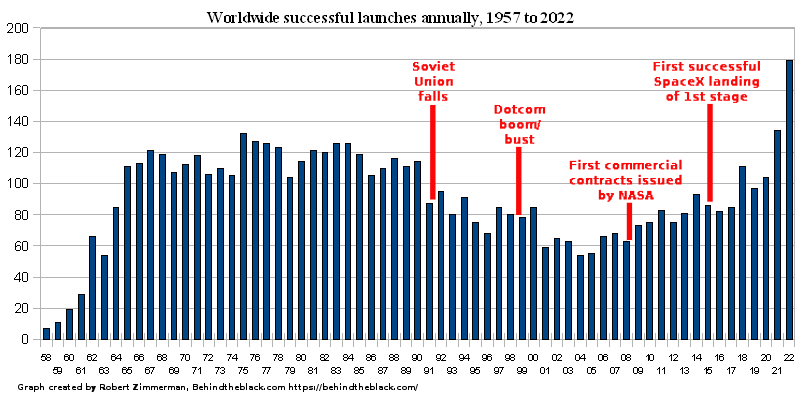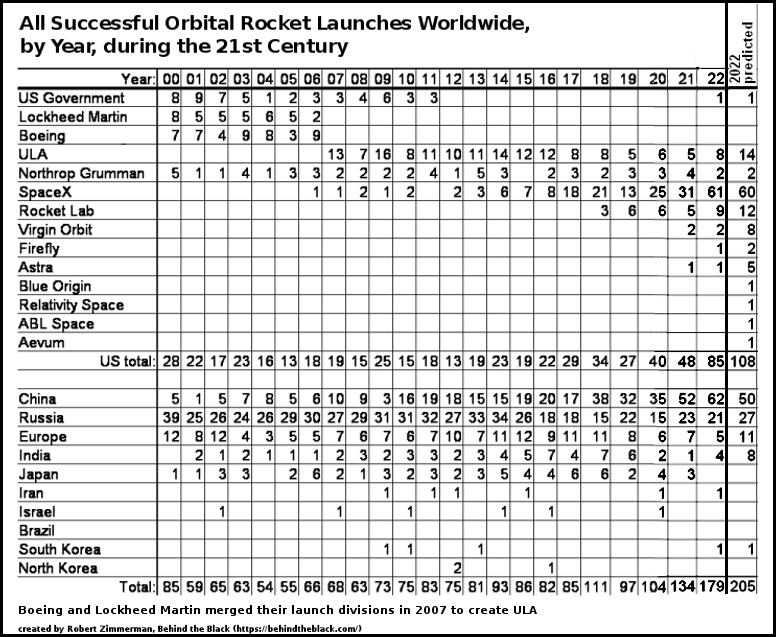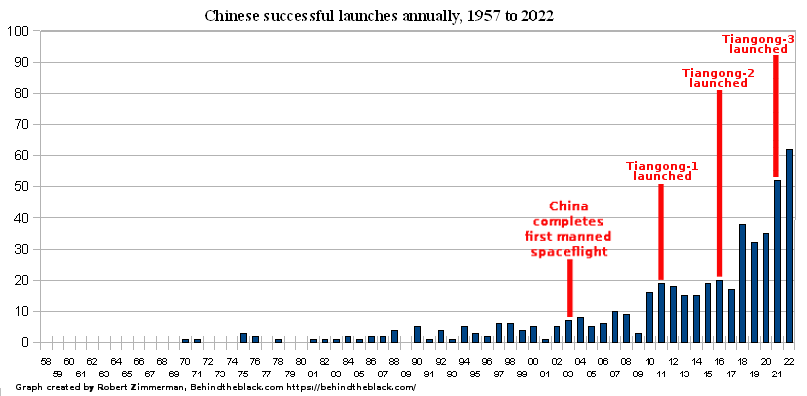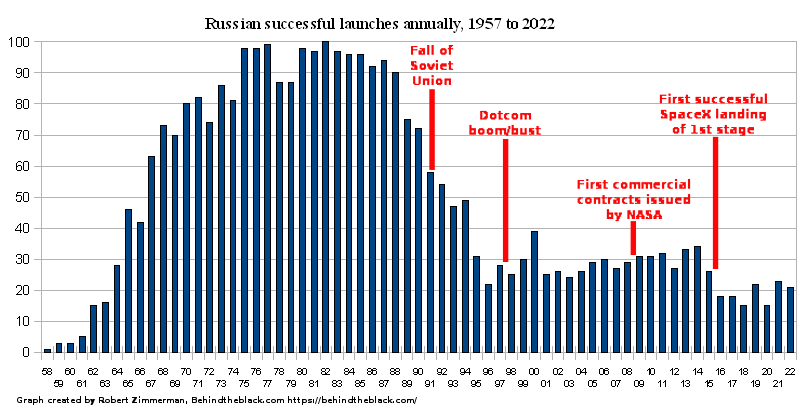Rocketry went BOOM! in 2022, but in a good way
In my 2021 annual report on the global launch industry, I noted that while 2021 was a banner year for the global launch industry:
Not all is sweetness and light of course. Competition and freedom always includes risk. Some of these new companies will certainly fail. The demand for launch services might not be enough to sustain them all. And factors outside the control of anyone, such as war and further panics like the Wuhan panic, could shut them all down.
In 2022 the launch industry not only topped 2021, setting a new record for successful launches in a single year, the industry was reshaped and changed by the very factors I warned about one year ago. The Russian invasion of the Ukraine resulted in Russia losing its one remaining satellite customer from the west, OneWeb, while the challenges of rocketry caused one already successful launch company, Astra, to suspend its launch services in order to develop a more competitive rocket.
Nonetheless, 2022 remained the most successful year ever in rocketry, smashing the record for successful launches in a single year, set the previous year, by more than 33%. The graph below illustrates well the unprecedented success of 2022.

Not only has the pace of launches been steadily rising throughout the first two decades of the 21st century, based on the activity in 2022 that rise appears to be accelerating with time.
To understand why there has such growth, the following graph breaks down the launch rate by nation and American private company during the 21st century.

First, the rise of private enterprise has continued, mostly because of the relatively new players, SpaceX and Rocket Lab. Rocket Lab established itself as a reliable rocket company capable of launching at least once per month. In 2023 it will initiate launches from its U.S. launchpad at Wallops Island, giving it three pads, with two in New Zealand. Expect this company to break its 2022 launch record again in 2023.
SpaceX meanwhile smashed its previous annual launch record, almost doubling it. Its achievement of 61 successful launches in 2022, almost all of which relied on previously launched first stages and fairings, exceeded the entire annual launch totals of the entire United States since Sputnik for every year except two, as shown in the graph below.

Elon Musk has said that SpaceX is now targeting 100 launches in 2023, and based on its track record it will not be a surprise if it succeeds.
Beyond SpaceX, the launch record set in 2022 was achieved almost entirely by private companies selling their products to customers, whether those customers were commercial satellite companies or government entities. Though NASA finally launched its SLS rocket in 2022, that rocket took eighteen years to create, cost about $60 billion, and was about seven years late. And it won’t launch again for another two to three years.
The launch record in 2022 was thus the result of Americans building private rockets competitively for profit, not a government space program dictating what everyone will do. Because of the chaotic freedom that competition engenders, combined with profits and actual achievement, expect that growth to continue.
For example, five new rocket startups (Firefly, Blue Origin, Relativity, ABL, and Aevum) had planned to complete their first launch in 2022. Only one succeeded, Firefly. Yet, the U.S. still had a record-breaking year.
Of the four companies that did not fly in 2022, three almost succeeded, but had to scrub or delay for technical reasons. The odds that all four will successfully launch in 2023 is quite high. Add these companies to the mix and in the coming years the American launch industry can only continue to be remarkably vibrant and competitive.
This American success is fueling similar private commercial efforts in Europe and India. If the new companies in these nations succeed, acting to replace the moribund government launch services that have done little in the past decade, than the growth in launches worldwide shall be stunning. Not only will American companies be competing against each other, they will be competing against new companies in Germany, India, and the United Kingdom.
Won’t that be exciting?
Meanwhile, competition between private companies has been further fueled by competition between nations. China, as illustrated by the graph below, continued its aggressive and ambitious space program, setting a new launch record while completing its own space station and a variety of challenging unmanned planetary missions to the Moon and Mars.

While China very clearly uses its space program for international prestige, it is also using it to train its politicians. A large number of the most important high level officials in China’s government started out as managers on various space projects. Those individuals now hold great power, and since they began as space cadets, expect them to support future Chinese space achievements whole-heartedly.
Moreover, with the space station Tiangong-3 fully assembled and in orbit, it is likely that China’s launch rate will remain steady or climb even higher in the coming years. China’s intends to occupy it continuously, which will require many launches. It is also negotiating with both Russia and Europe to team up to expand it.
Thus, assuming its economy does not collapse, China is going to be a major player in space, even leader, for many years to come.
Russia meanwhile has recovered surprisingly well from the loss of its international launch business, as shown in this graph:

If Russia had not invaded the Ukraine, it probably would have completed almost 30 launches in 2022, bringing its numbers back in the range seen from the mid-1990s to the mid-2010s. Still, it managed to maintain the same approximate launch rate seen in the past few years, rather than seeing a major drop off. Whether it can maintain this launch rate however is unknown. The Putin government says it wants to build its own independent space station to replace ISS, but there is no indication it has the funds or wherewithal to do so.
The competition between China, Russia, and the west, however, shall continue, and it will feed both their efforts as well as everyone else’s. As with last year, the signs now all point to a very bright future for space.
And as I also noted last year, other factors, such as economic collapse or unexpected war, could squelch this bright future in an instant. As Elon Musk himself said at a presentation in Boca Chica in February 2022,
“The window of opportunity [to build human settlements on other worlds] may be open for a long time, and I hope it is, but it may also be open for a short time. And this is the first point in the four and half billion history of Earth that it is possible.”
He added, “To be frank, civilization is feeling a little fragile these days.”
Based on the bad and irresponsible governance we have seen in the past three years, civilization appears more than a little fragile, it feels downright broken. And without a prosperous, hi-tech, and educated society, something that has existed for the past five hundred years, it will become quickly impossible to conquer the stars.
Instead, we will find it difficult to feed ourselves.
On Christmas Eve 1968 three Americans became the first humans to visit another world. What they did to celebrate was unexpected and profound, and will be remembered throughout all human history. Genesis: the Story of Apollo 8, Robert Zimmerman's classic history of humanity's first journey to another world, tells that story, and it is now available as both an ebook and an audiobook, both with a foreword by Valerie Anders and a new introduction by Robert Zimmerman.
The print edition can be purchased at Amazon or from any other book seller. If you want an autographed copy the price is $60 for the hardback and $45 for the paperback, plus $8 shipping for each. Go here for purchasing details. The ebook is available everywhere for $5.99 (before discount) at amazon, or direct from my ebook publisher, ebookit. If you buy it from ebookit you don't support the big tech companies and the author gets a bigger cut much sooner.
The audiobook is also available at all these vendors, and is also free with a 30-day trial membership to Audible.
"Not simply about one mission, [Genesis] is also the history of America's quest for the moon... Zimmerman has done a masterful job of tying disparate events together into a solid account of one of America's greatest human triumphs."--San Antonio Express-News


Happy New Year Robert. Thanks for this very interesting post. If convenient, could you publish the numbers for spaceX’s starlink/non-starlink launches as well as their piloted/cargo ISS missions
. Thanks.
Warren W. James: If you do a search on BtB for “Starlink” “launch” “race” you should get a list of every Starlink launch this year. From that you can figure out the count.
NPR summarized 2022 space activity on New Year’s morning, highlighting Webb, DART, and Artemis… but without mentioning this upstart company by the name of SpaceX!
No mention of 61 launches, nearly perfect rate of booster recovery, or multiple NASA and privately funded manned missions, all of which included balanced male-female crew membership. No mention that SpaceX currently provides the only US human launch capability and has for several years.
They did mention that SpaceX would probably launch Starship in 2023, and that Boeing would probably join the club in ’23 also.
NPR is part of the get-Musk MSM clown show! What a shameful performance.
Ray Van Dune—no surprise the taxpayer-funded NPR branch of the Ministry of Propaganda mostly ignores SpaceX. Now that Elon is actively exposing the government’s collusion with big tech social media to censor free speech, he and his companies will see increasingly strong headwinds. The slow rolling of the Texas Starship launch permit was just the beginning.
The PRC economy has, in many important ways, already collapsed. The regime will continue attempting to prop things up with deficit spending levels that make the antics in DC look positively sober and judicious by comparison, but there is a decidedly limited window during which this will continue to “work.” 2023 could well be the year we find out where the endpoint for this Potemkin economy – and the nation-state it supports – lies.
For the record, 33 of SpaceX’s 61 launches in 2022 were for Starlink. (There were 5 Dragon launches: 2 Commercial Crew missions to ISS, 1 Axiom crewed private mission to ISS, and 2 Cargo Dragon flights.)
I don’t have a tally handy for the number of sats launched in just 2022, but worth mentioning that to date, SpaceX has launched 3,666 Starlink sats, of which 3,284 are working; over half of those were launched in 2022. This is remarkable as an achievement, since it means that, quite literally, over half of all active satellites in Earth orbit today are built and operated by SpaceX.
That is the kind of achievement that the Space Shuttle was supposed to enable, but never did. Instead, it took a spergy South African immigrant dot-com goofball and a bunch of young renegade engineers and venture capital friends to do it, rather than a global superpower. And right now, you have to say that at least as far as space is concerned, SpaceX now *is* a superpower – hopefully, the first of more to come.
For those who really want to dive deep into the weeds of just what got launched into orbit, what it’s doing, and where it is, astronomer Jonathan McDowell has just completed his statistical summary of 2022 in space: https://t.co/AC8S4DgDLY Otherwise, Bob has provided us with a great bird’s eye view of just what this year has seen in space.
NPR summarized 2022 space activity on New Year’s morning, highlighting Webb, DART, and Artemis… but without mentioning this upstart company by the name of SpaceX!
We can’t ignore the probability that Elon Musk derangement syndrome is at work here, but I do wonder if this kind of thing is in some degree a function of the ignorance of whoever does NPR’s space beat, combined with long-ingrained habits of thinking and talking about space solely in terms of what government agencies happen to be doing. Because until the last few years, that pretty narly *was* all that was worth talking about, when you talked about space. There’s a handful of really good guys on the beat who know what’s up (Jeff Foust, Eric Berger, Christian Davenport, Irene Klotz, etc.), but pretty much every other major media outlet is just a bounty of ignorance.
But a new age is at hand, and the private sector’s role can no longer be ignored. Indeed, it is on the cusp of being most of the space story!
Basic Starlink numbers:
Google Turd….again.
As of November 2022, there are 3,271 Starlink satellites in orbit, of which 3,236 are operational, according to Astronomer Jonathan McDowell who tracks the constellation on his website.
Nov 23, 2022
The swamp is telling Musk to back off the Fauci files release he planned for later this week by dropping TSLA so the margin call on his levered loans gets kicked in.
“Stock market news live updates: Stocks fall in first trading day of 2023, Apple and Tesla sink
Tesla (TSLA) also continued a downslide to start the new year, plunging 12.2% — its biggest one-day drop in more than two years…
The company closed out its worst year on record in 2022, shedding 65%, or about $700 billion in market value. In December, growing concerns around production delays in China and CEO Elon Musk’s management of Twitter drove the stock down 36%, its biggest monthly drop since Tesla went public in 2010.”
https://finance.yahoo.com/news/stock-market-news-live-updates-january-3-2023-111400576.html
The number of launches is a good topic, but it falls short as a proxy for the amount of activity in space. If we are to conquer the solar system and the stars then space activity must increase to a level that supports this goal.
What is missed, or hidden, in the number of launches is the mass launched by these vehicles. However, even a number for the mass launched misses the usefulness and total activity of these missions.
Warren W. James’s request for information and Richard M’s reply are helpful in pondering the useful activities we perform in space. The activity level of the Deep Space Network may be another indicator of activity beyond Earth orbit. To conquer the solar system, we must first explore it, and robotic explorers give us a good initial look at objects that we may be interested in sending manned missions or give us indications that an object is not interesting enough for such advanced missions. Conquering the stars will require similar advanced exploration.
In these conquests, will planets be the main habitat for humanity, or will we choose to live in space-based habitats that do not require large amounts of energy to get into orbit?
Two decades ago, when private citizens finally achieved the goal of sending a man into suborbital space, an achievement that only three major-power governments had performed before, the U.S. government should have realized that it needed to continue advancing space technology.
In the past decade, commercial companies have grown to launching almost half the worlds launch vehicles to orbit or beyond. This is a relevant achievement and indicates the importance of providing space-related services to customers rather than governments providing space services mostly to themselves. We are eager to get returns from our activities in space, but for the past two-thirds of a century our governments have provided relatively little return for our tax money. No wonder so many people think that spending money on space projects is a waste of resources.
With the reduction in launch prices, more countries and companies are launching their own satellites and probes. This increase in space activity would not have been possible without commercial space finding efficiencies in launch services that governments failed to provide. Even the U.S. government gave up this goal when the Space Shuttle failed to provide low cost, frequent launch service. Instead of advancing the technology, the U.S. government chose to try to relive its past glory of the 1960s and return to the Moon, a goal of Jeff Bezos’s Blue Origin company. Fortunately, the U.S. government has allowed commercial space companies to advance the technology, and NASA has encouraged this transfer of responsibility to private commercial companies.
At some time in the future we should expect these kinds of launch reports to become obsolete, but for now, they give us some indication of what is going on and who is doing the going. Right now the going is being mostly done by commercial companies in the U.S., but with Germany, India, and the United Kingdom joining the club, will any of them beat out China in the coming years?